Math 1. Vectors
1. Vectors
What is a vector?
- Vector is a mathematical thingy with a length and a direction
- Often represented by an arrow (see next slide)
- Can have multiple dimensions (also called components)
- In our case usually 2 or 3:
- $x$, $y$, and possibly $z$
- Video games are full of vectors!
- Used for depicting position, velocity, acceleration, forces….
2D vector example
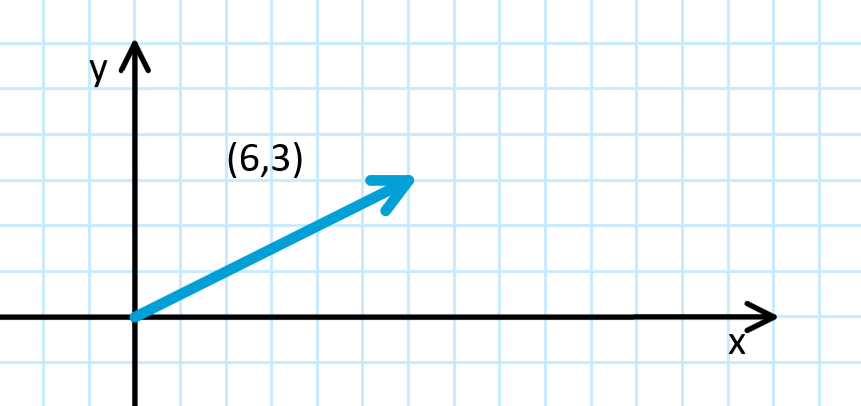
- This is a 2D vector $\vec{A} = (6, 3)$
- x-component $\vec{A}_x = 6$
- y-component $\vec{A}_y = 3$
- Vectors start from the origin, or $(0,0)$
-
In C#:
Vector2 vectorA = new Vector2(6,3);
2D vector length
- The length of a 2D vector is given by the Pythagoras theorem
-
$ \vec{A} = \sqrt{\vec{A}_x^2 + \vec{A}_y^2}$ -
$ (6,3) = \sqrt{6^2 + 3^2} = \sqrt{36 + 9} = \sqrt{45} \approx 6.7$
-
-
In C#:
float length = Mathf.Sqrt(Mathf.Pow(vectorA.x, 2) + Mathf.Pow(vectorA.y, 2));- Vector classes have a shorthand, too:
A.magnitude
- Vector classes have a shorthand, too:
Vector arithmetic
- Manual: Understanding Vector Arithmetic
- Let’s introduce the most important vector operations
- Addition
- Subtraction
- Scalar multiplication
- Extra: vector multiplication
- Dot product
- Cross product (WIP)
- C# examples included
Vector addition
- sum of two vectors is calculated by summing up the individual components
- $\vec{C} = \vec{A} + \vec{B}$ $= (3, 3) + (6, -2)$ $= (3 + 6, 3 - 2) = (9, 1)$
-
can be illustrated by moving $\vec{B}$ to start from the endpoint of $\vec{A}$
Vector2 A = new Vector2(3.0f, 3.0f); Vector2 B = new Vector2(6.0f,-2.0f); Vector2 C = A + B;
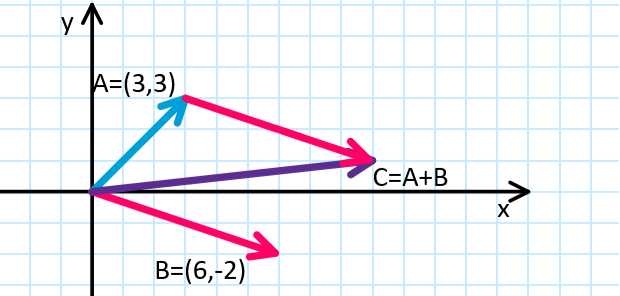
Vector subtraction
- difference of two vectors, $\vec{A} - \vec{B}$
- $-\vec{B}$ is is “flipped” $\vec{B}$: $\vec{B} = (6, -2) \Rightarrow -\vec{B} = (-6, 2)$
- $\vec{C} = \vec{A} - \vec{B}$ $= (3, 3) - (6, -2)$ $= (3 - 6, 3 - (-2))$ $= (3 - 6, 3 + 2)$ $= (-3, 5)$
-
$\vec{A} - \vec{B}$ starts from the endpoint of $\vec{B}$ and ends in the endpoint of $\vec{A}$
Vector2 A = new Vector2(3.0f, 3.0f); Vector2 B = new Vector2(6.0f,-2.0f); Vector2 C = A - B;
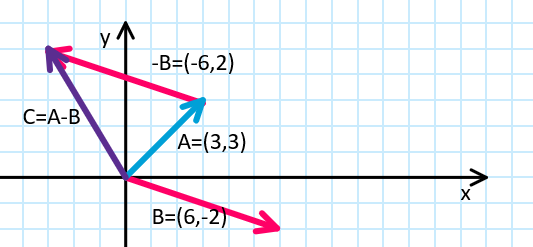
Scalar multiplication
- When a vector is multiplied by a scalar (a number), the vector is scaled
- If a vector is multiplied by 2, its length doubles $2 \cdot \vec{A}$ $= 2 \cdot (3,2)$ $= (2 \cdot 3, 2 \cdot 2)$ $= (6, 4)$
Vector2 A = new Vector2(3.0f,3.0f); Vector2 C = 2 * A;

Special cases for scalar multiplication
- If the scalar is negative, the vector gets flipped
- that’s what happened in subtraction
- $-\vec{A} = -1\cdot \vec{A} = -1 \cdot (6,4) = (-1 \cdot 6,-1 \cdot 4) = (-6, -4)$
- What about division?
- it’s basically multiplication as well
- $\vec{A} / 5 = \frac{1}{5} \cdot \vec{A} = \frac{1}{5} \cdot (6,4) = (\frac{1}{5} \cdot 6,\frac{1}{5} \cdot 4 ) = (\frac{6}{5},\frac{4}{5} ) = (1.2, 0.8)$
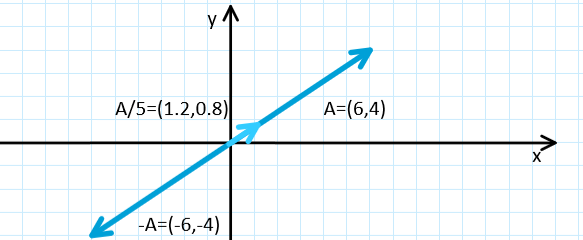
Vectors in Unity
Vectors in video games
- position
- velocity
- acceleration
- rotation
- forces
Vector classes
- Unity has two Vector classes, Vector2 and Vector3
- “2” and “3” here are the number of dimensions: (x,y) and (x,y,z)
-
Vector2 position = new Vector2(1.0f, 2.0f)
- Vector components can be accessed with the dot notation:
position.x,position.y,position.z
- Vectors can’t be directly modified:
- No:
position.x = 3.0f -
position = new Vector2(3.0f, position.y);
- No:
- Length of a vector can be acquired with
vector.magnitude
Velocity vector
- Velocity is an important concept in game development!
- It’s the rate of change of position
new_position = old_position + velocity;
- 3-dimensional velocity vector can be added like this to GameObject’s position in an
Update()method:transform.position += velocity;-
We can use player input, collision, etc. to adjust the velocity as needed
Note: Velocity vector is usually drawn so it starts from the moving object
-
(Remember, though, that vectors do not “know” its starting positions.)
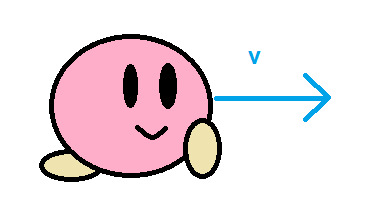
Acceleration vector
- Another important concept is acceleration
- It’s the rate of change of a GameObject’s velocity!
new_velocity = old_velocity + acceleration;
- We can use acceleration to change Rigidbody’s velocity
rb.velocity += acceleration;
- We can’t use that for GameObjects without rigidbodies, but we can store velocity in a separate variable
velocity += acceleration; transform.position += velocity; - This might seem like a cheap trick, but actually allows us to create smoother motion if we use player input, collision, etc to control acceleration instead of velocity
Distance vector
- To get the distance vector between two objects, we use vector subtraction
vector_B - vector_Atransform.position - otherGameObject.transform.position;
- To just get the length of the distance vector, a.k.a, the distance:
Vector2.Distance(vector_A, vector_B)
Special vectors of Unity
- See Static properties in Script Reference: Vector3
Vector3.right: the global $x$ axisVector3.up: the global $y$ axisVector3.forward: the global $z$ axis
Common vector operations
Normalizing a vector
- When we are not interested about the length of a vector, only its direction, it helps to normalize the vector
- Normalizing means setting the length of a vector to be $1$
- This is achieved by dividing the vector by its length
-
$\vec{A}_{normalized} = \vec{A} / \vec{A} $ - in C#, the normalized version of any vector can be easily accessed:
Vector2 UnitVector = A.normalized;
Rotating a vector
- In Unity, rotation is represented by Quaternions (fin. kvaternio, kvaterniot)
- To rotate a vector by a given angle, you can do a Quaternion rotation operation:
Vector3 rotatedVector = Quaternion.Euler(0, 0, 90) * originalVector;- This isn’t a regular multiplication, so do note that Quaternion.Euler has to be on the left side of the vector.
- To rotate a Quaternion:
myQuaternion *= Quaternion.Euler(0, 0, 90); - Note: the Transform and Quaternion classes have many rotation methods available, see Transform Class: Rotation
Extra: Dot product - Vector’s alignment with another vector
- If you want to know how much two vectors point to the same direction, we can use the dot product
- The dot product returns a number, not a vector!
- $\vec{A} \cdot \vec{B} = A_{x} \cdot B_{x} + A_{y} \cdot B_{y} + A_{z} \cdot B_{z}$
- For normalized vectors,
Vector3.Dotreturns- $1$ if they point in exactly the same direction
- $-1$ if they point in completely opposite directions
- $0$ if the vectors are perpendicular
Dot product example
- Check if two rigidbodies are moving to the same direction:
float alignment = Vector3.Dot( _rigidBody.velocity.normalized, otherGameObjectRigidBody.velocity.normalized)
Note about distance
- Note: when performance is important, using magnitude can be a bad idea: it includes the costly square root operation
- if you need to only compare magnitudes, or you’re squaring it right away, use
.sqrMagnitudeinstead!
- if you need to only compare magnitudes, or you’re squaring it right away, use
Exercise 1. I’m being avoided
Create a scene with two GameObjects, a player and a static enemy. Calculate the distance between the player and the enemy.
If the distance is smaller than some given threshold value,
- ⭐ Change the color of the enemy (and set the color back to default when you’re no more on the range)
- ⭐⭐ Make the enemy shoot at player!
- ⭐⭐⭐ Move the enemy farther away from the player along the shortest possible path.